This is an old revision of the document!
Table of Contents
Settings
Customize this program to your needs with detailed, even aircraft-specific settings. Change map colors, SimConnect settings and many more options available.
But although a lot of very detailed customization options are available in this modules, FS-FlightControl is designed in a way that you do not have to touch anything here to just use the program.
It is perfectly usable with the default settings and only if you need something special then this is the right place to look at.
Aircraft Related Settings
All settings in this area will be saved together with the corresponding aircraft profile if aircraft related settings are enabled.
Aircraft Profile

By default aircraft related settings are disabled as this is not needed for many users, especially also if you only use FS-FlightControl with one specific aircraft type.
But if you want to use FS-FlightControl together with very different aircraft types it makes sense to enable aircraft related settings here.
Profile Settings
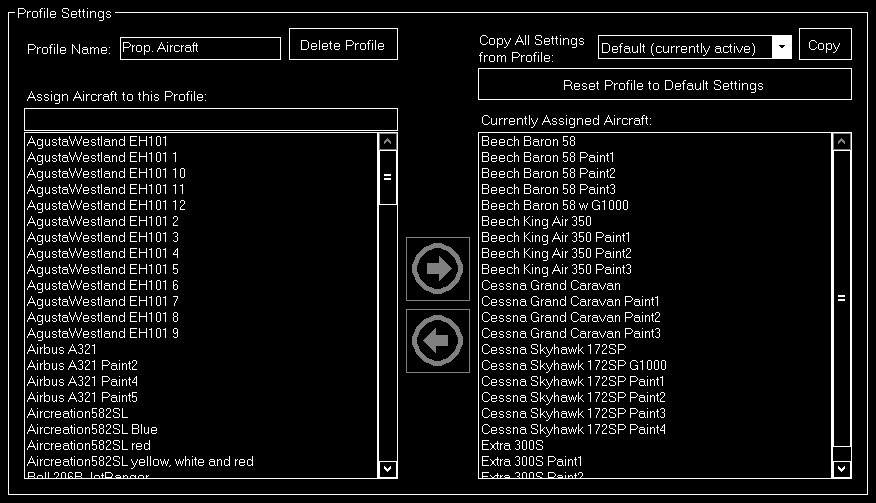
If aircraft related settings are enabled the profile settings section gets enabled as well.
You can edit or create new aircraft profiles here and change the flight simulator aircrafts that are assigned to the current aircraft profile.
Additionally you can copy all settings from another profile or revert all settings to default.
Position
These settings are related to the Position module.
Final Position
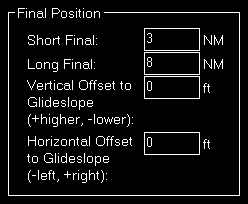
Here you can define the distance of the short and long final approach as well as a vertical and horizontal offset to the glideslope if you want.
Vectors Position
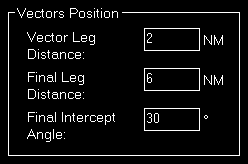
The distances for the vector positions can be changed here as well as the final intercept angle.
Base Position

Define here the distances for the base positions.
Downwind Position
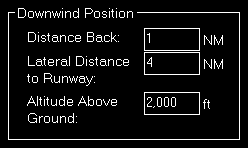
Here you can define the lateral distance to the runway for the downwind positions.
In contrast to the other positions where the altitude is calculated based on the runway glideslope automatically, the altitude for the downwind positions can be customized here.
Airworks
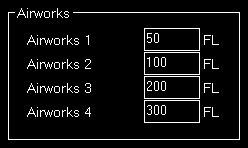
You can define the flight levels of the four airworks buttons here.
Options on Position Change
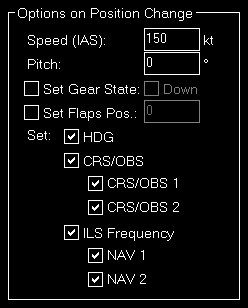
Depending on the aircraft capabilities you can change the parameters that are used when the aircraft is positioned.
This includes whether the heading, course (CRS) respectively omni bearing selector (OBS) or ILS frequency (if the runway is ILS enabled) should be set automatically with the aircraft position change to a certain approach.
Map Colors
These settings are related to the Map module.
Colors and Text Settings
In this area you can highly customize the appearance of the map.
We decided to put this into the aircraft related settings. Although this seems not to be aircraft related at first sight, but this enables you to emphasis certain map parts based on the currently loaded aircraft: For example when using a small aircraft you might want to highlight more the small gates and do not care a lot about ILS, but when using a big jet the large gates are much more interesting. Same goes for other parts on the map which might be more interesting for certain aircraft types than others.

All colors and text sizes can be defined per map type.
Therefore please first select the map type.
Colors and Text Sizes for Map Type
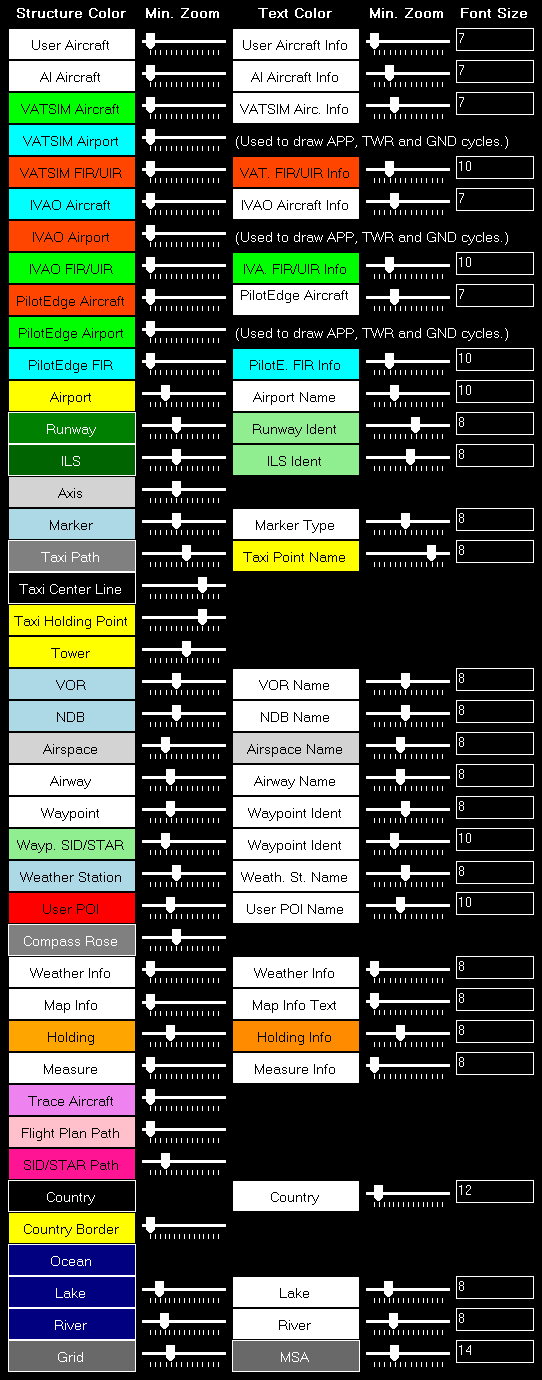
Here all currently defined colors and text sizes are displayed for the selected map type.
The Structure Color is always the color of the item itself, like the runway surface of the runway, whereas Text Color the color of the corresponding text is, like the runway idents of the runway.
The Min. Zoom next to the Structure Color defines the minimum map zoom level needed that this structure (like the runway surface) is shown. Accordingly the second Min. Zoom next to the Text Color defines the minimum map zoom level needed that the corresponding text (like the runway idents) is shown.
Font Size, the last column, enables you to define the size of the displayed text.
Parking
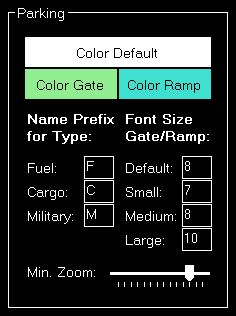
This area lets you define colors and text sizes for the different parking types like gates and ramps depending on their sizes.
Additionally you can define text prefixes to be used for a certain type like fuel, cargo or military.
Tooltip
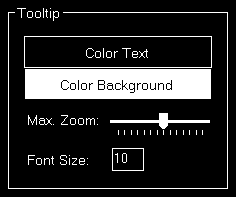
When hovering over certain map elements like an airport a tooltip is displayed shown the full name of the airport.
In this section you can define the appearance of this tooltip as well as the maximum map zoom level until that the tooltip should be displayed.
Map Other
These settings are related to the Map module.
Auto Zoom
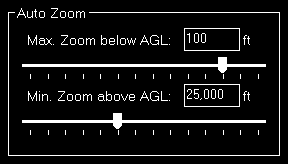
The Map module also features an auto zoom function which will zoom the map in and out according to the current aircraft altitude.
You can configure this feature here by first entering the maximum zoom level (fully zoomed in) that should be reached if the aircraft is below the entered altitude above ground.
Then, for the upper end, you define the minimum zoom level (fully zoomed out) that should be reached above the entered altitude.
Between these two altitudes the zoom will be equally divided automatically.
Aircraft Display
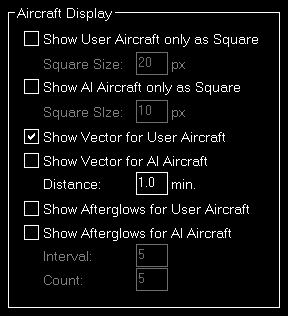
Here you can choose from certain options related to the display of the aircraft on the map.
First you can define if the user and/or AI aircraft are only shown as squares instead of an aircraft image. In this case you can also enter a size for the squares.
Furthermore you can enable or disable a distance vector being displayed in front of each user and/or AI aircraft. In this case you can enter the length of the vector in minutes.
Additionally so called afterglows - dots behind the aircraft - can be enabled or disabled for user and/or AI aircraft. In this case you can enter an interval as well as the number of dots that should be displayed.
Reposition
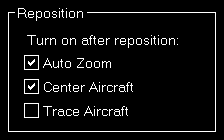
In this section you can define if certain map features are automatically turned on after the map reposition function was used.
Compass Rose
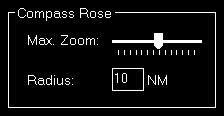
Use these settings to define the maximum zoom level up to the compass rose (when this function is enabled) should be displayed and how wide its radius should be.
Other
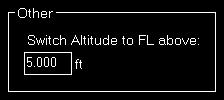
Here you can define at which altitude the display should switch from precise altitude display to flight level.
 Note: Above this altitude it will also switch from show MSL altitude to indicated altitude.
Note: Above this altitude it will also switch from show MSL altitude to indicated altitude.
Pushback
These settings are related to the Pushback module.
Speed Options
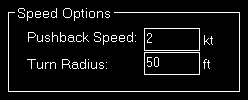
Here you can define the pushback speed as well as the turn radius.
Failures
These settings are related to the Failures module.
Failures Source

Here you can choose the source of the failures that are displayed in the Failures module.
 Note: For some options additional parameters need to be entered in the Third Party settings first.
Note: For some options additional parameters need to be entered in the Third Party settings first.
Aircraft
These settings are related to the Aircraft module.
Aircraft Warnings
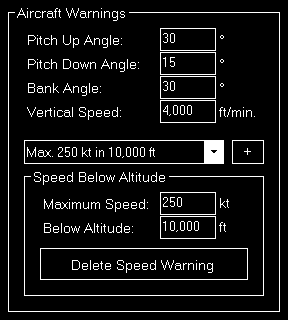
Here you can set limits for some parameters like pitch or bank angle for the aircraft.
Speed Below Altitude
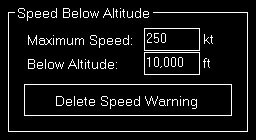
Additionally you can define maximum speeds below certain altitudes above mean sea level (MSL).
These settings are used to change the color of the corresponding value to red on the Aircraft module and also to shown warning indicators when exporting graph data to Google Earth on the Statistics module.
Aircraft-Specific Options

For some third-party add-ons there are some additional options available. You can enable this support here.
 Note: Some third-party add-ons require additional parameters to be entered in the Third Party settings first.
Note: Some third-party add-ons require additional parameters to be entered in the Third Party settings first.
Other

Here you can define if flap positions should be shown as degree number.
Statistics
These settings are related to the Statistics module.
Google Earth Export
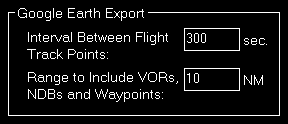
Define all Google Earth export related settings in this area.
Every certain time interval a flight track point is shown in Google Earth with detailed flight information. You can set this time interval here.
Additionally you can define the range for including VORs, NDBs and waypoints if their export is enabled.
Not Aircraft Related Settings
All settings in this area are not aircraft related and will be saved globablly.
Position
These settings are related to the Position module.
General
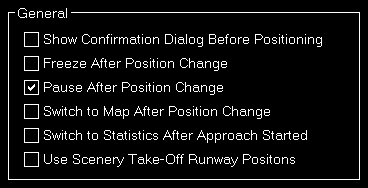
You can enable or disable some automatizations after an aircraft position is changed.
First choose if position freeze or pause should be enabled after aircraft move.
Additionally you can define if the program should automatically switch to the Map module after a position change respectively to the Statistics module when an approach is started.
Finally you can choose if the scenery should be reloaded after a position is changed.
 Note: The forced scenery reload is enabled by default as disabling it may lead to unexpected results (like aircraft crash) especially if the new location is far away from the old one.
Note: The forced scenery reload is enabled by default as disabling it may lead to unexpected results (like aircraft crash) especially if the new location is far away from the old one.
Flight Situation Presets

You can choose here to not automatically save the flight plan together with a flight situation preset.
Map
These settings are related to the Map module.
Data Update Rate

You can define here how often the map view gets updated.
By default that is set to once per second.
Custom Update Rate

If you uncheck the Default Update Rate checkbox you can define the update rate yourself.
The slider then ranges from very low (every 60 visual frames on flight simulator) to very high (every single visual frame).
 Note: Please keep in mind that setting the data update rate to very high may lead to performance issues.
Note: Please keep in mind that setting the data update rate to very high may lead to performance issues.
Grid and Minimum Sector Altitude (MSA) Display
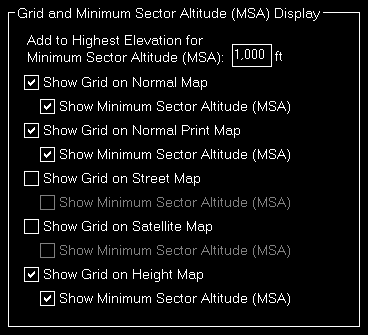
First you can define here the altitude that is added to the highest elevation in each sector when calculating the Minimum Sector Altitude (MSA).
Additionally you can choose when the map grid including the Minimum Sector Altitude (MSA) is displayed in the first place.
Print Options

For map printing you can define here which printer should be used.
Additionally, if you own a commercial license, you can also change the footer text or remove it completely.
Within the footer text you may use the placeholders {date} and {time} to insert the current date and time.
Display Options
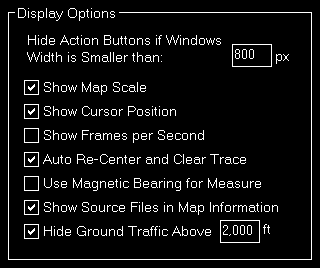
You can define several display options here.
First you can set a window width below that the left and right action buttons are hidden.
 Note: This is only used for detached map windows.
Note: This is only used for detached map windows.
Below that you can choose if you want the map scale, cursor position and frames per second displayed on the bottom of the map view or not.
Online Networks
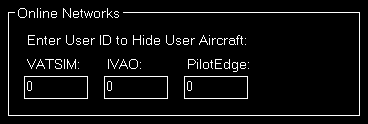
If you enter here your user ID of the available online networks your own user aircraft will not appear additionally as AI aircraft.
Flight Plan
These settings are related to the Flight Plan module.
Flight Plan Folder

Here you can change the path to the saved flight plans of flight simulator.
Conditions
These settings are related to the Conditions module.
Weather Engine

Let FS-FlightControl know here which software is used as weather engine to ensure all features of the Conditions module work properly.
 Note: For Active Sky additional parameters need to be entered in the Third Party settings first.
Note: For Active Sky additional parameters need to be entered in the Third Party settings first.
Real-Time Weather Source

Define here the real-time weather source that should be used for receiving weather METAR data if this is not provided by flight simulator directly.
In this connection you can choose from NOAA (National Oceanic and Atmospheric Administration), VATSIM (Virtual Air Traffic Simulation) and IVAO (International Virtual Aviation Organization).
ILS Visibility
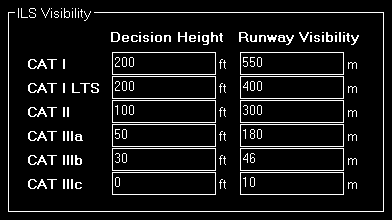
In this section the ILS Visibility presets can be customized.
You can define the decision height as well as the runway visibility for each ILS category.
Failures
These settings are related to the Failures module.
Color Settings
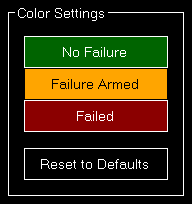
Use this area to change the colors.
You can also use the button Reset to Defaults to revert all your color changes.
Other

Choose here if random failures should be automatically re-enabled on program start if they were enabled before.
Statistics
These settings are related to the Statistics module.
Color Settings
In this area you can customize all colors used to draw the statistics graphs.

All colors can be defined per display type.
Therefore please first select if you want to change the colors for the normal in program display or for printout.
Revert to Defaults

You can easily revert all colors to their defaults by using the Revert to Defaults button.
Colors for Display Type
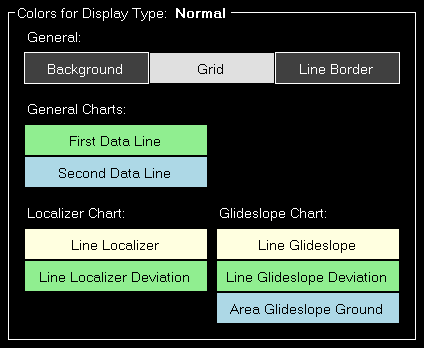
Here all currently defined colors are displayed for the selected display type.
Click on any of the button to select a different color.
Print Options

For statistics printing you can define here which printer should be used.
Additionally, if you own a commercial license, you can also change the footer text or remove it completely.
Within the footer text you may use the placeholders {date} and {time} to insert the current date and time.
Network
These settings are related to the Network module.
FS-FlightControl Client
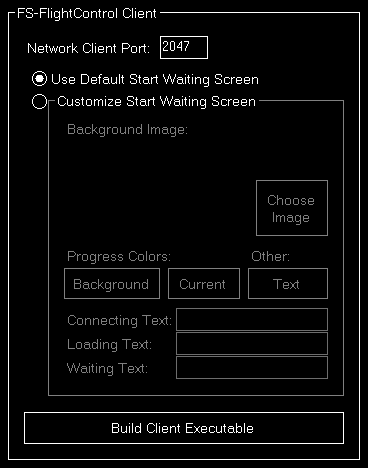
First you can change the network client port here that defaults to 2047, but can be changed to any other port number if needed.
 Note: If you change the port you need to re-build the network client executable.
Note: If you change the port you need to re-build the network client executable.
Customize Start Waiting Screen
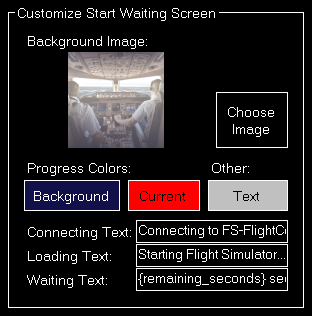
If you own a commercial license you can completely customize the start waiting screen that is shown on the network client computers.
You can select a background image as well as customize the colors and the shown texts.
In the Remaining Text input field you can use the placeholder {remaining_seconds} to insert the remaining seconds.
Program Close Options

You can define here if a shutdown, hibernate or sleep action should be sent to all connected network computers when the FS-FligthControl software is closed.
Additionally you can decide if the same action should be executed on the computer running the instructor station itself.
Status Page for Web Display
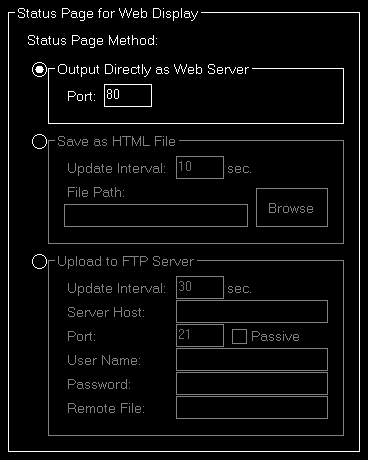
In this area you can define the method that should be used for the status page output.
Output Directly as Web Server

If this method is selected FS-FlightControl will listen on the defined port for HTTP web requests and will reply with the status page accordingly.
Save as HTML File
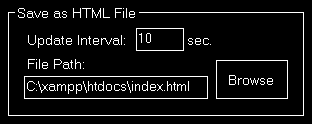
This method will save the status page as HTML file to a certain directory location in the defined time interval.
Upload to FTP Server
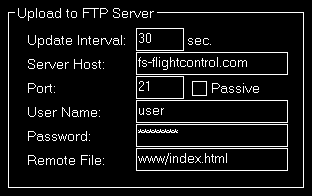
You can also enable this method to automatically upload the status page to a FTP server.
Then you need to define again the update interval as well as all parameters that are needed for FTP server access.
SimConnect
SimConnect is the flight simulator integrated connection method for external application.
Also FS-FlightControl uses this technology to connect to flight simulator.
In this section you can define corresponding parameters.
SimConnect Library

This section enables you to control which SimConnect library is used to connect to flight simulator.
Choose SimConnect Version Automatically

By default the SimConnect version is detected automatically and just for information the used DLL library is shown here.
Force Using this SimConnect DLL

If for whatever reasons that should be necessary you can define a path to a certain SimConnect DLL library here.
This disables the automatic detection completely.
 Note: This really should only be done if the automatic detection fails. Normally it should not be necessary to change anything manually here!
Note: This really should only be done if the automatic detection fails. Normally it should not be necessary to change anything manually here!
SimConnect Network Access

If you want FS-FlightControl to access a flight simulator installation that is not located on the same computer as FS-FlightControl itself, these SimConnect Network Access parameters need to be defined.
They are directly written to the global SimConnect.cfg file. To reset everything to its defaults you can just delete this file again completely.
 Note: To make this configuration as easy as possible you can use the SimConnect Network Wizard.
Note: To make this configuration as easy as possible you can use the SimConnect Network Wizard.
Database Rebuild
This section is related to the main program database.
Database Synchronization

The database synchronization is explained in the Database Build installation section.
Navigation Data Update

This area is explained in the Navigation Data Update dialog section.
Mobile Devices
This section is related to the mobile devices support.
Android and iOS Client
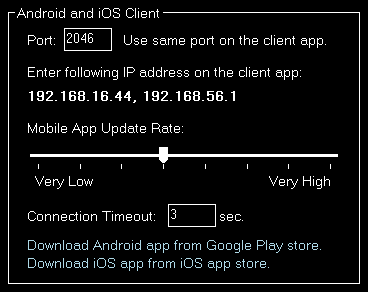
There is an Android client app that makes it possible to use FS-FlightControl also with your Android Tablet device.
You can define the port here that should be used for the connection. It defaults to 2046.
In the following you can see the IP address that you need to enter in the Android app once for connection.
 Note: It rares cases it is possible that there is more than one IP address displayed here. In this case you just need to try which one works.
Note: It rares cases it is possible that there is more than one IP address displayed here. In this case you just need to try which one works.
If you should see a Windows Firewall message popping up - normally on program start - asking you to give FS-FlightControl access please confirm that. Only with this approval you will be able to connect with your mobile device.
You can directly download the Android app from the Google Play storeas well as the iOS-App from the iOS App Store.
Third Party
Here you can define necessary parameters to connect to third party products supported by FS-FlightControl.
ProSim

The host or IP as well as the port that should be used to connect to ProSim can be entered here. The ProSim connection then can be used in the Flight Plan and Failures modules.
AST

The host or IP as well as the port that should be used to connect to AST (Aircraft Simulation Technology) can be entered here. The AST connection then can be used in the Failures module.
Project Magenta

The path to the NetDir of Project Magenta can be entered here. The Project Magenta connection then can be used in the Flight Plan module; the Failures module uses FSUIPC to connect to Project Magenta.
Flight Sim Labs

The path to the FSLabs directory of Flight Sim Labs below the flight simulator directory can be entered here. The direct Flight Sim Labs connection then can be used in the Flight Plan module.
Brunner Elektronik

The host or IP as well as the port that should be used to connect to the CLS2Sim software by Brunner Elektronik can be entered here. The Brunner Elektronik connection then can be used in the Motion module.
Active Sky

The host or IP as well as the port that should be used to connect to Active Sky 16 (SP1 required) can be entered here. The Active Sky connection then can be used in the Conditions module.
PFPX

You can enter the path to the PFPX documents directory here. The PFPX connection then can be used in the Flight Plan module.
Aerosoft Airbus

Now you can enter the path to the Aerosoft Airbus documents directory (also the older Extended Version is supported) here. The Aerosoft Airbus connection then can be used in the Flight Plan module.
Wilco Airbus

You can enter the path to the Wilco/FeelThere Airbus directory here. The Wilco Airbus connection then can be used in the Flight Plan module.
Mindstar
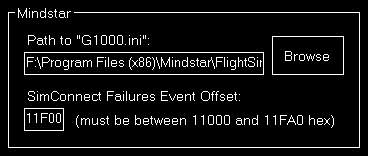
You can enter the path to the Mindstar G1000.ini file here. The Mindstar connection then can be used in the Failures module.
Additionally the offset for the SimConnect event IDs need to be specified as hex value. Starting from this ID the SimConnect events will be assigned to the Mindstar G1000 failures.
Flight1

The host or IP as well as the port that should be used to connect to Flight1 VISPRO flight simulator plug-in can be entered here. The Flight1 connection then can be used in the Failures module.
 Note: To be able to trigger the Flight1 G1000 failures from FS-FlightControl not only the Flight1 G1000 plug-in needs to be installed in flight simulator, but also the Flight1 VISPRO plug-in.
Note: To be able to trigger the Flight1 G1000 failures from FS-FlightControl not only the Flight1 G1000 plug-in needs to be installed in flight simulator, but also the Flight1 VISPRO plug-in.
General

Additional you can define the time interval for third party synchronization here.
Other Settings
In this section all other settings are located that do not fit anywhere else.
Units

Here all units for input as well as output used across the whole program can be defined.
Altitude Unit

Choose if feet (ft) or meters (m) should be used for altitude values.
Temperature Unit

Choose if Fahrenheit (°F) or Celcius (°C) should be used for temperature values.
Atmospheric Pressure

Choose if Hektopascals (hPa) or Inches of Mercury (inHg) should be used for atmospheric pressure values.
Short Distance Unit

Choose if feet (ft) or meters (m) should be used for short distance values.
Far Distance Unit

Choose if nautical miles (NM) or kilometers (km) should be used for far distance values.
Weight Unit

Choose if kilograms (kg) or pounds (lbs) should be used for weight values.
Speed Unit

Choose if knots (kt), miles per hour (mph) or kilometers per hour (km/h) should be used for speed values.
Liquid/Fuel Unit

Choose if kilograms (kg), pounds (lbs) or US gallons (gal.) should be used for liquid and fuel values.
Visibility Unit

Choose if feet (ft), meters (m), kilometers (km) or statute miles (M) should be used for visibility values.
Color Settings

Use this area to change colors used all over the software.
You can also use the button Reset to Defaults to revert all your color changes.
Input and Help

Here you can define if a touch input helper should be used for text and selection input fields.
 Note: While the Android or iOS app is connected both touch input helpers are activated automatically.
Note: While the Android or iOS app is connected both touch input helpers are activated automatically.
Additionally you can choose if the small help icons should be displayed in the top right corner of all sections.
Furthermore you can make the FS-FlightControl window to stay always on top of all other applications.
Program Startup Options
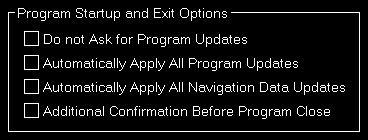
To allow a program start without user interaction you can define here that program updates as well as navigation data updates should always be applied without confirmation by the user.
Alternatively you can also disable the question regarding an update completely.